Many parents and caregivers are interested in white noise for infants. It can greatly improve their sleep quality. White noise has been used for decades to help babies sleep better.
Inside the womb, white noise is about 90 decibels, like a lawnmower. This is why many babies find it soothing. It helps mask noises that can wake them up, making it a key tool for parents.
Studies on infant white noise show promising results. A 2018 study found that colicky newborns cried less and slept more with white noise. A 1990 study showed 80% of infants fell asleep in 5 minutes with it.
The American Academy of Pediatrics (AAP) also supports white noise machines. They should be far from the baby’s sleep area.
Using white noise helps babies develop good sleep habits early. It can be from machines, apps, or even household items. The goal is to find a sound that helps the baby sleep well.
With the right white noise, parents can get a better night’s sleep. They know their baby is sleeping safely and soundly.
What is White Noise for Infants?
White noise for infants is a sound with many frequencies at the same intensity. It sounds even and doesn’t change. Baby white noise can be found in sounds like a fan or a lawnmower.
A white noise machine for baby helps create a sleep-friendly space. These machines make sounds like fans or appliances. Studies show white noise helps newborns sleep fast, with 80% falling asleep in five minutes.
Not all white noise is good for babies. Pink noise is better for older babies, starting at four months. Always use a white noise machine safely. Keep the volume low and the machine far from the crib.
Benefits of White Noise for Infant Sleep
Research shows white noise greatly improves infant sleep. Studies found that white noise benefits for infants lead to better sleep quality and longer sleep times. In fact, 80% of newborns fell asleep in just five minutes with white noise. This is compared to 25% without it.
The white noise sleep aid for infants also helps parents feel less stressed and anxious. It makes sleep environments consistent, helping babies fall asleep quicker and stay asleep longer. Some key benefits include:
- Improved sleep quality and duration
- Reduced stress and anxiety for parents
- Alleviation of colic symptoms
It’s important to use white noise machines safely and correctly. The American Academy of Pediatrics suggests keeping levels at or below 50 decibels. This is as quiet as a dishwasher. By following these guidelines, parents can help their babies sleep better and improve their overall health.
Different Types of White Noise
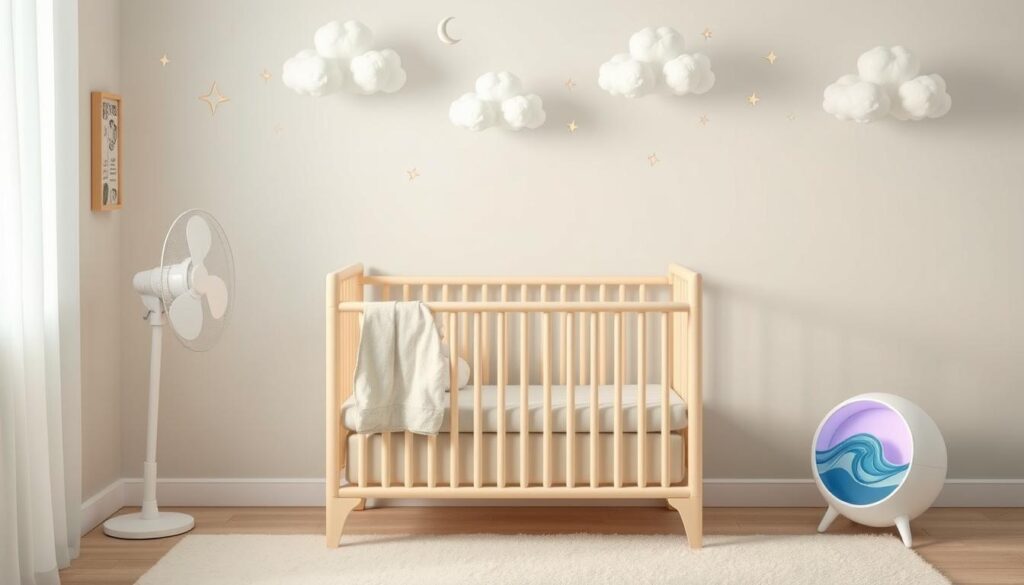
White noise therapy for babies comes in many forms. This includes fan and appliance sounds, and nature sounds. These sounds help babies fall asleep faster and sleep better.
Fan and Appliance Sounds
Fan and appliance sounds are great for helping babies sleep. You can use a fan or a sound machine to make these sounds. Some machines even let you adjust the volume and set a timer.
Nature Sounds
Nature sounds, like rain or ocean waves, are also soothing for babies. You can find these sounds in nature or use a sound machine. Many machines offer different nature sounds for parents to choose from.
Popular sound machines for babies include the Nod and the Dohm Nova. These machines have a variety of sounds, including fan and appliance sounds, and nature sounds. They also let you adjust the volume and set a timer.
Safety Considerations for Using White Noise
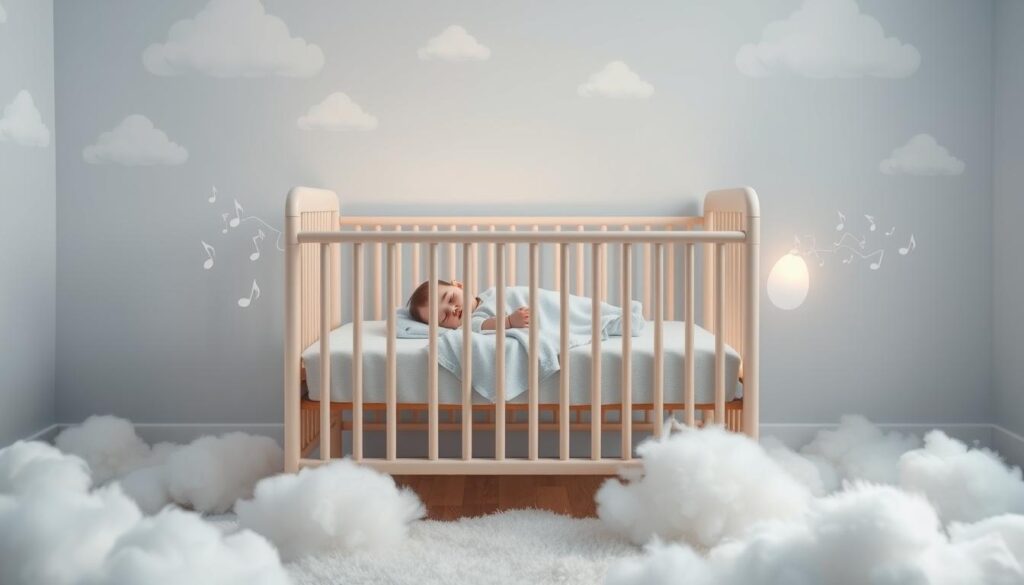
When using white noise for infants, safety is key. The American Academy of Pediatrics suggests keeping white noise machines 7 feet away. The volume should be under 50 decibels to avoid hearing damage and health issues.
Some important safety tips for white noise use include:
- Volume levels: Keep the volume at or below 50 decibels to mimic the sound of a quiet conversation.
- Distance from the crib: Place the white noise machine at least 3-6 feet away from the baby’s crib to minimize direct exposure.
White noise can help babies sleep better. But, it’s vital to follow these guidelines for safety. By watching volume and distance, parents can help their babies sleep well without risks.
Always be careful with infant white noise. If you’re unsure about a white noise machine or worry about your baby’s hearing, talk to your pediatrician. They can give you advice tailored to your baby’s needs.
How to Introduce White Noise to Your Infant
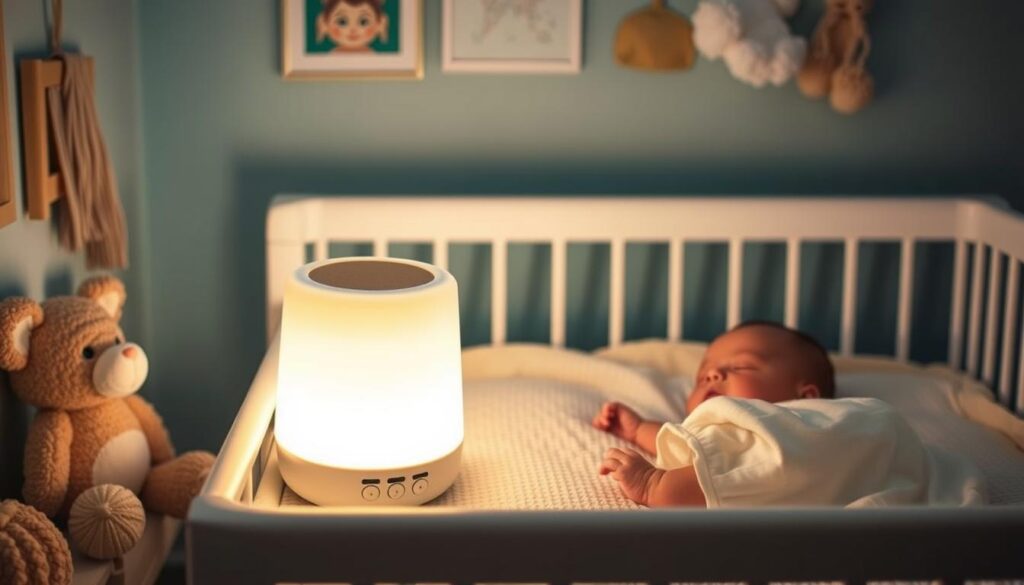
Introducing baby white noise can change your infant’s sleep for the better. Studies show it can calm a fussy baby and help them sleep longer. Start with a slow approach to introduce white noise.
Begin with a soft volume and slowly turn it up if needed. Consistency and patience are important. Start with short white noise sessions during naptime and increase them as your baby gets used to it.
Creating a bedtime routine is key. Include white noise, like reading or singing, to signal sleep time. These steps can help your baby sleep better and longer, thanks to a white noise machine.
Some benefits of using baby white noise include:
- Improved sleep quality
- Longer sleep periods
- Reduced risk of sleep disruptions
By introducing white noise slowly and consistently, you help your baby sleep better. This improves their sleep quality and habits.
White Noise Machines vs. Apps
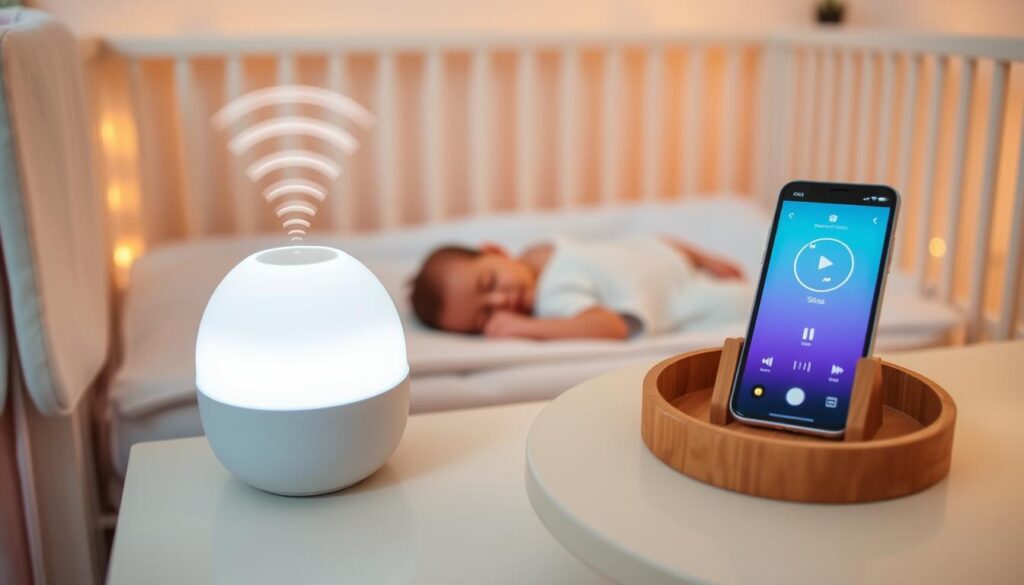
Parents have two main choices for white noise for babies: machines and apps. Both can help babies sleep better. But they have different features and benefits.
White noise machines are devices that make constant sounds. Apps are software for phones or tablets. Some popular white noise apps have many sounds and options. This makes them easy for parents to use.
When picking between machines and apps, think about volume, sound quality, and how easy they are to use.
Here are some important things to remember:
- Volume control: Machines usually have better volume control. Apps might use the phone’s volume.
- Sound quality: Machines often have better sound quality. Apps can be affected by the phone’s speaker.
- Convenience: Apps are easier to use because they’re on phones or tablets.
The choice between machines and apps depends on what you prefer and need. By looking at what each offers, parents can choose the best for their baby’s sleep.
Common Concerns About White Noise
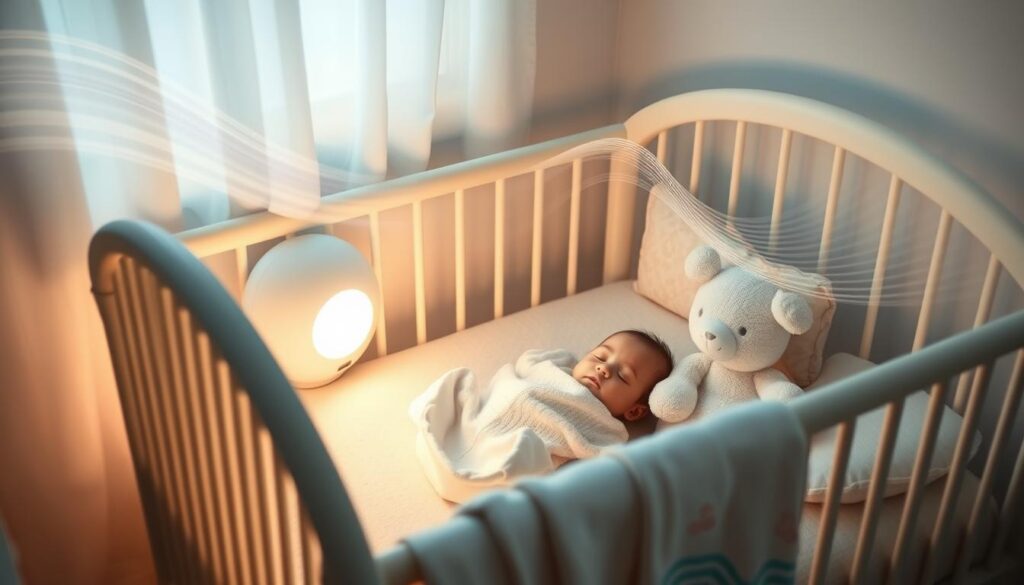
Some parents worry about white noise therapy for babies. They fear it might lead to bad habits or harm their hearing. But studies show that soothing white noise for infants can help them sleep well without harm.
The American Academy of Pediatrics (AAP) says sound machines, like white noise, can help babies and toddlers sleep better. They recommend keeping the volume at 50 decibels or less. This is as loud as a normal conversation. Also, the machine should be at least 7 feet away from where the baby sleeps.
Concerns about bad habits are valid. But using white noise machines wisely can help. Here are some tips:
- Use the machine at a safe volume.
- Place it at a recommended distance from the baby.
- Turn it off during awake times to avoid auditory issues.
By following these tips, parents can ensure their babies get the benefits ofwhite noise therapy for babies. This way, they can create a healthy sleep space withsoothing white noise for infants.
Tips for Optimal White Noise Use
Creating a sleep-friendly environment is key for babies to sleep well. White noise can help a lot. It’s important to pick the right spot and time for it. The American Academy of Pediatrics says to keep white noise machines 1 foot away and volume under 50 decibels to avoid hearing harm.
Here are some tips for using white noise with babies:
- Put the white noise machine far from the crib to keep sleep uninterrupted.
- Use a machine with volume controls to get the sound just right.
- Try different sounds, like fans or nature, to see what works best.
White noise helps babies sleep better, which is good for them and their parents. By following these tips, parents can help their babies sleep deeper and better. This helps with growth and development.
Parent Testimonials on White Noise
Many parents say baby white noise has changed their baby’s sleep for the better. A study found that 80% of newborns fell asleep in just five minutes with white noise. This shows how well white noise works for helping babies sleep.
Parents have shared how a white noise machine for baby sleep has helped. They say it makes their babies sleep better and longer. For instance, one parent mentioned their baby slept 8 hours straight after using it.
Experts also back using white noise for baby sleep. Pediatricians say to put white noise machines at least 7 feet from a baby’s crib. They also recommend using it all the time for the best results.
Using white noise for baby sleep has many benefits. These include:
- Improved sleep quality
- Increased sleep duration
- Reduced stress and anxiety for parents
Alternatives to White Noise for Sleep
Some parents look for other ways to help their babies sleep, aside from white noise. Soft music and lullabies are great options. Studies show music can help babies relax and fall asleep. The best music for this is slow, with a beat of 60 to 80 beats per minute.
Another choice is using nature sounds as a white noise sleep aid for infants. Some machines play sounds like rain, ocean waves, and forest noises. These can help babies sleep as well as white noise. Pink noise, with its deeper sound, might even help with sleep and memory.
- Soft music and lullabies
- Nature sounds, such as rain or ocean waves
- Pink noise, which is similar to white noise but with a deeper tone
- Brown noise, which has deeper bass sounds than white or pink noise
Remember, even with these alternatives, safety is key. Keep the volume low and the machine far from the baby’s ears.
How to Create a Sleep-Friendly Environment
Creating a sleep-friendly environment is key for infant sleep. White noise therapy for babies is a big help. A dark, quiet room with a comfy temperature is best. The room should be between 68-72°F (19-21°C).
Lighting matters too. A dark room helps sleep better. Soothing white noise for infants makes the room sleep-friendly. Keeping a regular sleep routine is also important. Bedding made of natural fibers, like cotton or bamboo, keeps babies cool.
- Keep the room temperature steady
- Use dark curtains or blinds to block light
- Use white noise therapy for babies to help sleep
- Choose natural fibers for bedding
By following these tips, parents can make a room that helps babies sleep better. Soothing white noise for infants is a great tool for this.
When to Stop Using White Noise
As your baby grows, you might wonder when to stop using white noise for sleep. White noise is most helpful for babies up to 18-24 months. Some parents keep using it until their child is 3-4 years old if it helps them sleep well.
Signs It’s Time to Transition
Here are signs it’s time to wean your child off white noise:
- Your child can fall asleep on their own without white noise
- They don’t seem as comforted by the white noise anymore
- They don’t want to sleep without the white noise machine
Gradual Weaning Process
Start weaning off white noise slowly over 3-5 days. Begin by making the volume lower during naps. Then, lower it at bedtime. After that, turn the machine off completely. This gradual change helps your child get used to sleeping without white noise.
